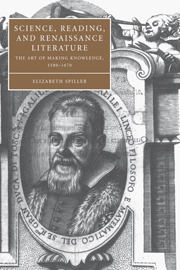Book contents
- Frontmatter
- Contents
- List of figures
- Acknowledgments
- Introduction: making early modern science and literature
- 1 Model worlds: Philip Sidney, William Gilbert, and the experiment of worldmaking
- 2 From embryology to parthenogenesis: the birth of the writer in Edmund Spenser and William Harvey
- 3 Reading through Galileo's telescope: Johannes Kepler's dream for reading knowledge
- 4 Books written of the wonders of these glasses: Thomas Hobbes, Robert Hooke, and Margaret Cavendish's theory of reading
- Afterword: fiction and the Sokal hoax
- Notes
- Index
- Cambridge Studies in Renaissance Literature and Culture
2 - From embryology to parthenogenesis: the birth of the writer in Edmund Spenser and William Harvey
Published online by Cambridge University Press: 22 September 2009
- Frontmatter
- Contents
- List of figures
- Acknowledgments
- Introduction: making early modern science and literature
- 1 Model worlds: Philip Sidney, William Gilbert, and the experiment of worldmaking
- 2 From embryology to parthenogenesis: the birth of the writer in Edmund Spenser and William Harvey
- 3 Reading through Galileo's telescope: Johannes Kepler's dream for reading knowledge
- 4 Books written of the wonders of these glasses: Thomas Hobbes, Robert Hooke, and Margaret Cavendish's theory of reading
- Afterword: fiction and the Sokal hoax
- Notes
- Index
- Cambridge Studies in Renaissance Literature and Culture
Summary
Edmund Spenser and William Harvey are two central Renaissance figures who are in their different ways responsible for defining the disciplines they have come to represent. Spenser is arguably the first significant poet in English literature to define his identity principally as a poet. Harvey not only discovered the circulation of the blood; he also articulated a theory for science that sought to define new scientific practices by distinguishing such practices from those of philosophers, artists, and explorers. Spenser and Harvey are crucially present when our modern ideas of poetry and science are established, yet they are rarely if ever discussed together. If the idea of poetry seems to us very separate from the idea of science, we can say this because of how successful Harvey was in using a kind of a Spenserian model of poetry as the basis for his own new theory of science. What this chapter argues is that Spenser's The Faerie Queene and William Harvey's Disputations Concerning the Generation of Animals are discipline-defining texts because of their shared interest in theorizing the creation of knowledge. Each work addresses and tries to account for the origin of ideas in order to practice a method for making new knowledge for readers. As we shall see, it is not quite an exaggeration to say that the poet Spenser must become something of a scientist in order to give to his reader the knowledge that will make The Faerie Queene, just as the scientist Harvey must become something of a poet in order to complete experiments in Disputations.
- Type
- Chapter
- Information
- Science, Reading, and Renaissance LiteratureThe Art of Making Knowledge, 1580–1670, pp. 59 - 100Publisher: Cambridge University PressPrint publication year: 2004



